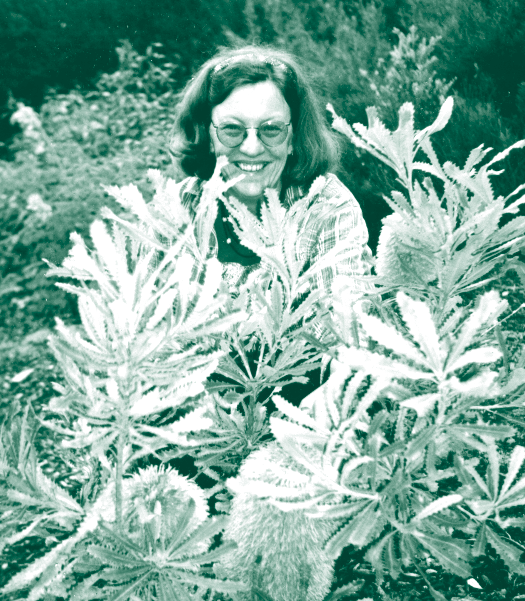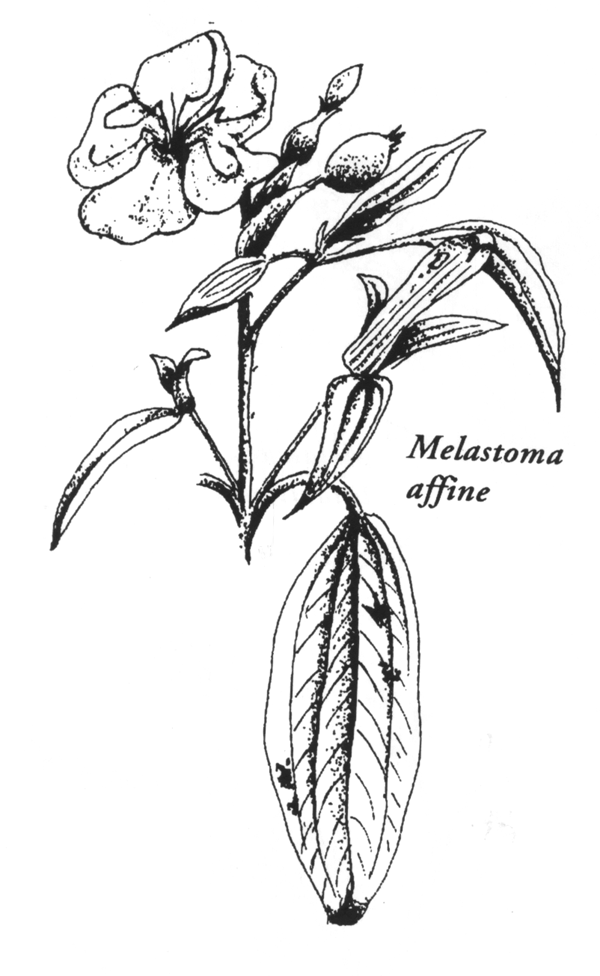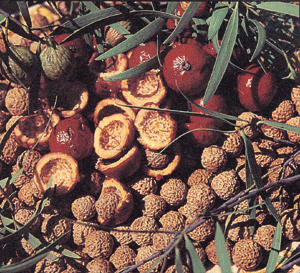|
Issue 18 Bee Rediscovered After 99 Years!From `Aussie Bee, July 2001
|
|
|
Dr Ken Walker, a specialist in Homalictus beesHomalictus rowlandi was fine. Ken left his family in Kuranda and explored a road through a rainforest, looking for bees feeding on the rainforest flowers. He found some really good Ligostrum lucidum flowers and patiently caught bees and examined his finds from 10 in the morning until 3 pm. At last it was time to go back but Ken decided to try just one more time. He looked at his catch and suddenly he saw it. `You beauty!' he shouted. He recognised it immediately - it was another Homalictus rowlandi! Ken's journey from Melbourne to north Queensland and back had taken five weeks and covered 13,000 km but he considered the effort most worth-while. He had rediscovered one of Australia's rarest native bees - Homalictus rowlandi, the bee that had been lost for 99 years. page 12). Bees that have large eyes like this tend to fly at dusk so Ken thought that perhaps these bees might be adapted to the dim conditions of a Kuranda rainforest. In the steamy heat of January 2001, Ken arrived in Kuranda with his family for a native bee hunt. This was the middle of the wet season and it was raining every afternoon. However, on this particular day it from Museum Victoria, was intrigued by this species and longed to find it once again. The only existing specimens of this rare species were held by the British Museum in London. Ken discovered that these bees had unusually large ocelli (the three simple eyes which are located at the top of a bee's head.
|
Index: 18Pharmaceutical properties of Qld Rainforest plants Toxicity results - 'all clear' Aboriginal use of Moreton Bay Chestnut
|
MEMORIALVale Denise Reason An Amateur Bushfoodie about our garden. Your courage has given me the courage to face whatever the future has to offer me and to put our future plans into operation. I will further develop our native garden. I will continue our involvement with the Bushfoods Association. I will split our native bee hive this spring, build more bird boxes, care for the frog pond, continue with your habitat history and attend to the many chores which we once did together. You will always be beside me. While I mourn your passing, I know that this earth is a better place from your presence. Many people and creatures have breathed easier because you lived. You have brought love and laughter and kindness and comfort to many during your stay with us. You have won the affection of many and you were respected by all who knew you. Rob Reason 3/7/01
Rob Reason dedicates this tribute to his wife Denise who passed away in March after a year-long battle against cancer. Denise and Rob were foundation members of the Queensland Bushfoods Association (Member 23). I found my one love, Denise Jorgensen, when we were both students at Brisbane State High School in the mid fifties. We fell in love, married in our teens, and raised seven beautiful children in our forty five year partnership. In 1976, we settled on suburban acreage at Everton Hills. Here, with my help, Denise established a native garden which eventually focused more and more on native food plants. Denise found that many Australian native fruits, nuts, greens, roots, leaves, shoots and aromatic herbs have tantalizing, unique flavours that offer new and delicious taste sensations which enhance the quality and bounty of our country's cuisine and produce. She became an advocate for them in her quiet but resolute way. Her garden did not grow willy-nilly. She created a garden that is a self-sustaining ecosystem, a garden where she did not have to water, weed, artificially fertilize or use poisons. Each specimen was carefully selected after scrupulous research.She considered soil type, moisture requirements, light needs, leaf fall and root system. She loved giving her visitors and friends plants from her nursery to take home, or some of the exquisite jam which she made from her own produce in her own kitchen to her own recipes. She was especially thrilled last Christmas when the Bushfood Association organised two field days in her sanctuary in Bunya Road. Though close to death she proudly led her visitors through her pride and joy. Denise made her last planting two months before her death. She was delighted with the result. "I have dirt on my hands and feet once more.", she exuded with her beautiful smile. But it was the last time she ventured into her wonderland of nature. Hence forth confined to her bed (she wanted to die at home) she was content to hear the bush sounds - something denied her in the sound-proofed, sterile hospitals which she hated. To her one of the exciting things about growing plants from seed was the inherent chance of difference. Whatever their condition she allowed her plants to grow at their own natural pace with grace. She also acknowledged that sometimes some beautifully flourishing specimens died for no apparent reason. I am sure this allowed her to come to terms with her own mortality. Denise is now at peace in the garden she so lovingly created and nurtured. Her ashes were scattered beneath a favorite tree (Elaeocarpus bancroftii). Denise, my wife, my mate, I still crave your physical presence but I can sense your nearness as I move Love Song for a sweet spirit, speed forth A gentle soul there was who walked a while upon this lovely planet, Earth - Denise, her name, serene her task of caring for its species and their place to thrive, Whilst sharing with like-minded amateurs the story of its sweets, its delights. Now, amateurs are lovers, sure and true. Her love was steadfast for her friends, her man, her family, and all those other stewards of the wild she cherished, preserved to know. But love's labour is not ever lost, with every effort yielding manifold returns of fellowship and valued trust. There is no fear for her now in that unspoiled environment of endless love, joy, peace. John Wrench. 27/3/01 |
|
 One of Australia's rarest native bees
is a 5 mm long red-brown species called Homalictus rowlandi. It
had not been seen since two specimens were collected
in 1902 by Turner in Kuranda, north Queensland!
One of Australia's rarest native bees
is a 5 mm long red-brown species called Homalictus rowlandi. It
had not been seen since two specimens were collected
in 1902 by Turner in Kuranda, north Queensland!


